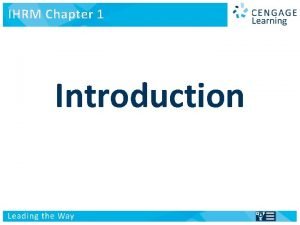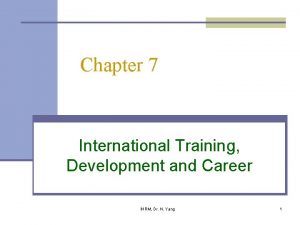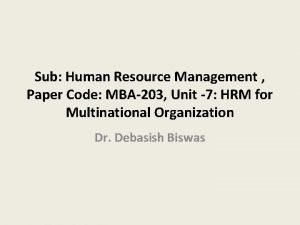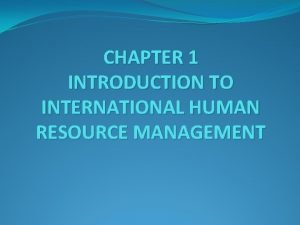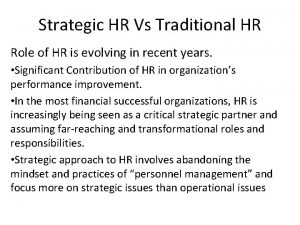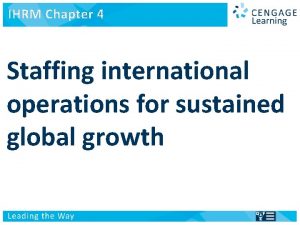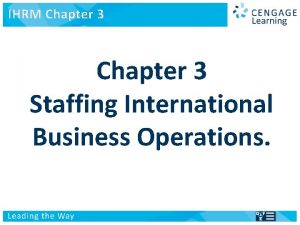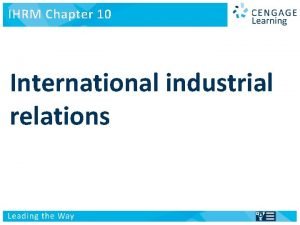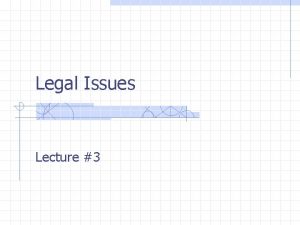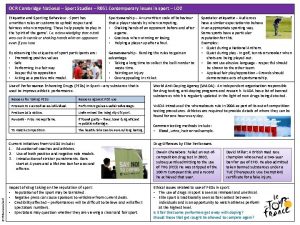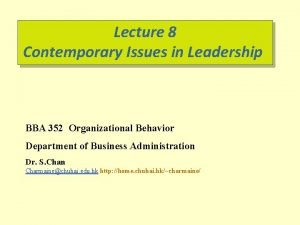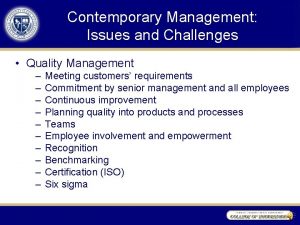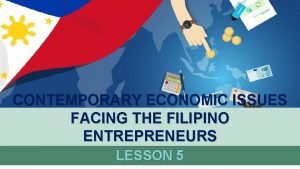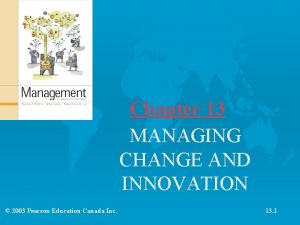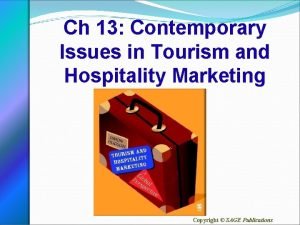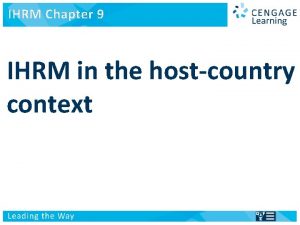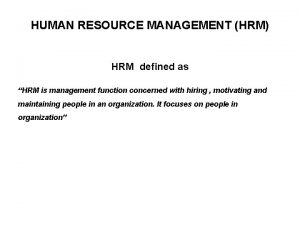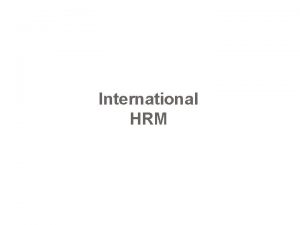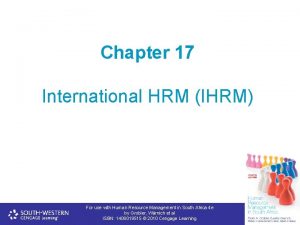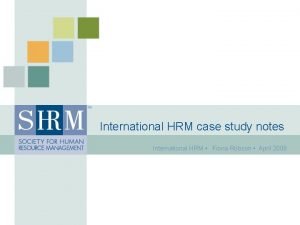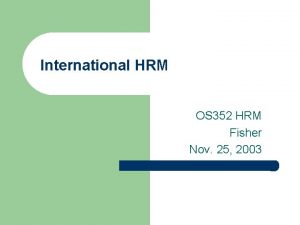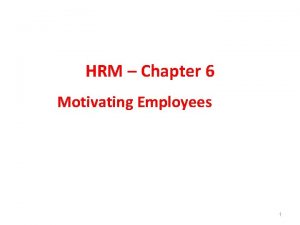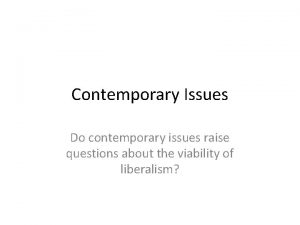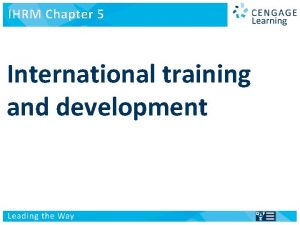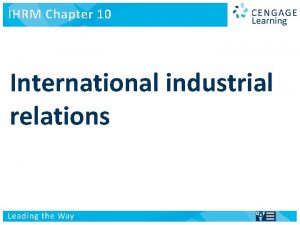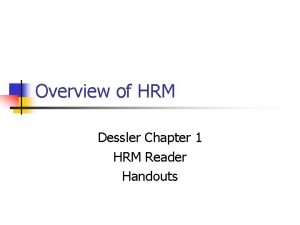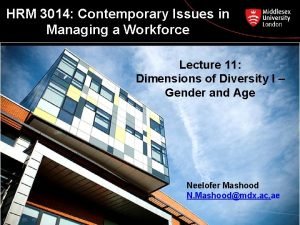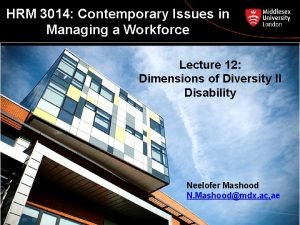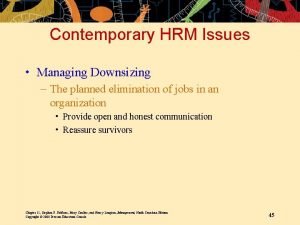INTERNATIONAL HRM Chapter 10 Contemporary issues in IHRM



















- Slides: 19

INTERNATIONAL HRM Chapter 10 Contemporary issues in IHRM

Multinationals and Electronic Human Resource Management n Electronic human resources (e. HR): automation of various aspects of the human resources system of a company

Strategic Benefits of e. HR Systems n Reduce HR and administrative system cost n Boosts productivity n Improve HR services to employees n Employees take control of their own data n Repository of the wealth of knowledge and skills of expatriates n Employee tracking for career management and other HR purposes n Repository of information for outside stakeholders

Proper Steps to e. HR Implementation n Develop business case to justify using e. HR or upgrade to e. HR n Make the system customer-focused n Be proactive n Organize collected data in ways that is useful to the organization

Strategic HR Issues in International Assignments n Approaches to sending employees abroad: n Administrative approach involves merely assisting the employee destined for an international assignment with paperwork and minor logistics n Tactical approach involves managing the “risk or failure” factor of overseas assignment by providing paperwork assistance and a modest amount of training. n Strategic approach involves extensive support and coordination of the international assignment and a strategized repatriation Copyright © 2002 South. Western. All rights reserved. 14– 5

Copyright © 2002 South. Western. All rights reserved. 14– 6

Strategic HR Issues in International Assignments (cont’d) Copyright © 2002 South. Western. All rights reserved. 14– 7

Setting Strategic HR Standards Copyright © 2002 South. Western. All rights reserved. 14– 8

Reading 14. 1: Managing a Global Workforce: Challenges and Strategies n Challenges: n Deployment in getting the right skills to the right place in the organization regardless of geographic location. n Knowledge and innovation dissemination and transfer where all business units concurrently receive and provide information. n Talent identification and development of those employees with the abilities and skills to function effectively in a global organization. Copyright © 2002 South. Western. All rights reserved. 14– 9

Reading 14. 1: Managing a Global Workforce: Challenges and Strategies n Strategies for managing the global workforce: n Develop aspatial careers for employees that provide rich contextual knowledge of the environments and cultures in which organization operates. n Provide specific awareness building assignments that develop cross-sensitivity to cultural intricacies of a global enterprise in high potential employees in a short time. n Utilize SWAT teams of experts deployed on a short-term basis to solve operational problems and complete technical projects. Copyright © 2002 South. Western. All rights reserved. 14– 10

International Labor Relations n Key issue: degree to which organized labor can limit the choices of an international business. n Labor concerns: Counter bargaining power with threat to move jobs off-shore. n Keep high-skill work at home and ship low-skill work to foreign plants. n Importing employment practices and contractual agreements from the home-country. n © Mc. Graw Hill Companies, Inc. , 2000 18 -14

Strategy of International Labor n Try to establish international labor organizations. n Lobby legislatures to restrict multinationals. n Use United Nations to regulate multinationals. Efforts have not been successful. © Mc. Graw Hill Companies, Inc. , 2000 18 -15

Multinationals’ Approach to Labor Relations n Decentralize: labor laws, union power and nature of collective bargaining varies from country to country. n Centralize: Want to rationalize global operations. n Need to control labor costs and maximize threat of move to lower cost country. n Before move, get new union approval for work practices. n © Mc. Graw Hill Companies, Inc. , 2000 18 -16

Strategic IHRM • HRM has become more strategy-oriented than traditional personnel management. Ø Corporate strategy may emanate from the centre, but the roles of national environments and diverse stakeholders now impact on HRM. • IHRM has evolved as the management of people in diverse locations has grown in importance for MNEs. • IHRM takes in three elements: Øcorporate strategy, Øenvironmental factors and Øpolicies & practices.

The transnational manager • The transnational manager understands and adapts to differing cultures, often moving among several of the firm’s foreign locations. • The requirements – a blend of knowledge, skills and abilities: • Knowledge of relevant foreign language • Understanding of foreign business practices • Ability to adapt to differing cultural environments • Inter-personal skills • Training and cultural acclimatization improve the likelihood of success in the international assignment.

Figure 9. 6: The transnational manager

Cross-cultural teams • Teamworking may be internal to the company or involve partner firms. • The benefits of cross-cultural teams: • Participants gain understanding of different perspectives and ways of doing things, building cross-cultural competencies. • Diversity is a creative spur, generating more ideas. • Cross-cultural teams reflect the firm’s differing locations. • Teamworking among culturally diverse people involves reaching a consensus on purpose, roles and methods of decision-making.

Acquisitions and IHRM • Cross-border mergers and acquisitions now encompass companies from both developed and developing countries • Can involve privatization of a state-owned organization, or a state-controlled company taking over a privately-owned firm • Issues which arise: • Whether the targeted firm will have to slim down operations, and how • How to reconcile differing corporate cultures and HR policies • Degrees of integration are possible from independence to full integration.

19
 Contemporary issues in hrm
Contemporary issues in hrm Ihrm definition
Ihrm definition Training in ihrm
Training in ihrm Difference between hrm and hrd
Difference between hrm and hrd Objectives of ihrm
Objectives of ihrm Introduction to international hrm
Introduction to international hrm Traditional hr structure
Traditional hr structure Ihrm objectives
Ihrm objectives Virtual assignment in ihrm
Virtual assignment in ihrm International industrial relations in ihrm
International industrial relations in ihrm Legal issues in hrm
Legal issues in hrm What is contemporary health issues
What is contemporary health issues Contemporary issues in management ppt
Contemporary issues in management ppt R051 contemporary issues in sport
R051 contemporary issues in sport Contemporary leadership issues
Contemporary leadership issues Contemporary management issues
Contemporary management issues Contemporary issues in marketing
Contemporary issues in marketing Economic issues faced by the filipino entrepreneurs
Economic issues faced by the filipino entrepreneurs Contemporary issues in managing change
Contemporary issues in managing change Contemporary issues in tourism meaning
Contemporary issues in tourism meaning

